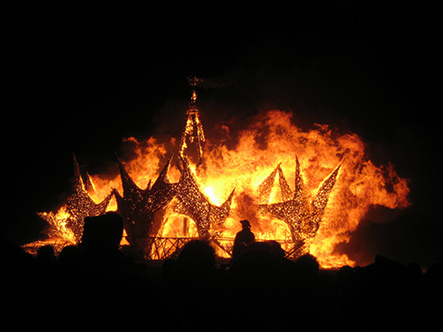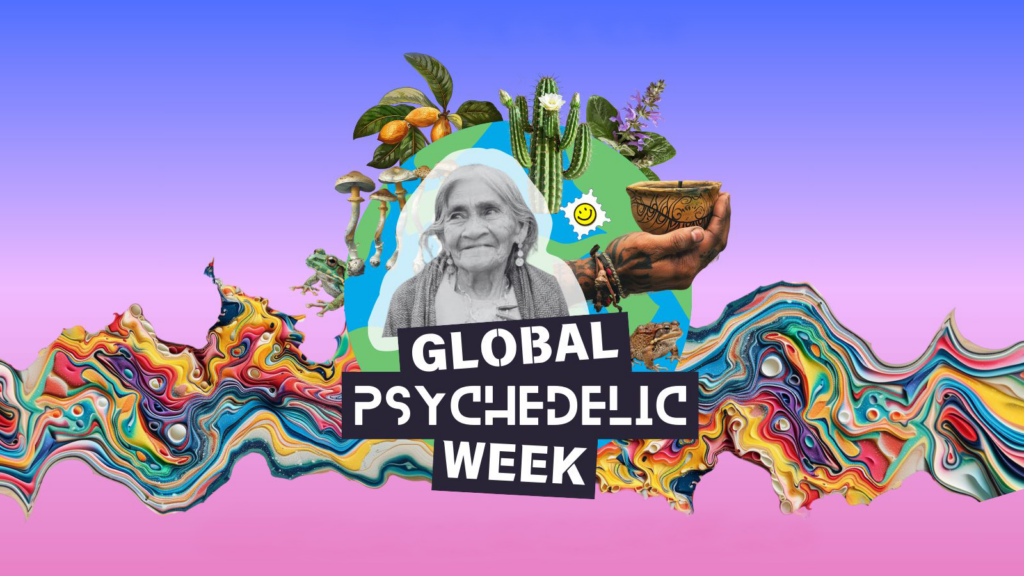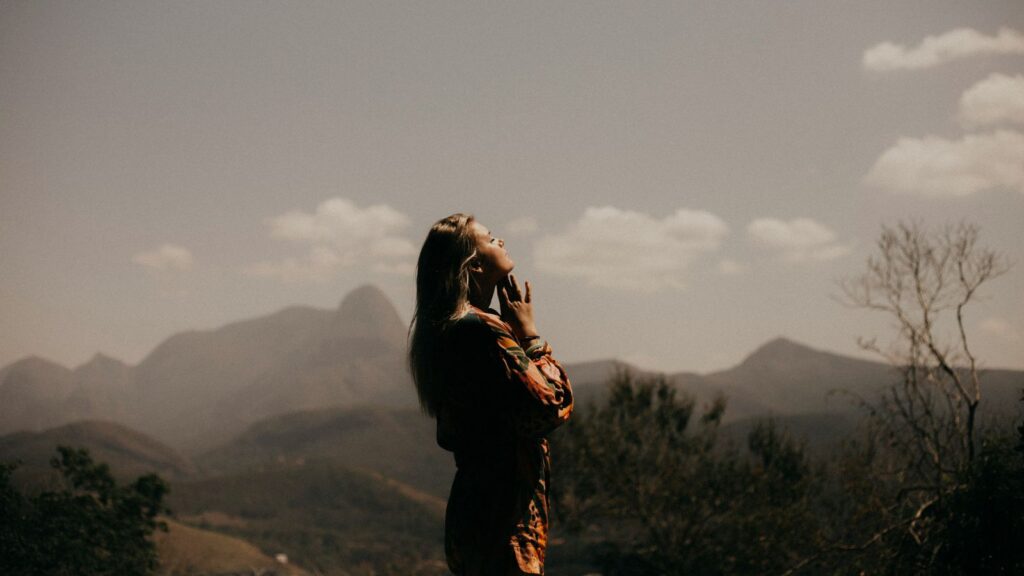Of the many things for which San Francisco is notorious,
Buddhism and Burning Man are undoubtedly near the top of the list. Home to the
first Buddhist temples in the US, the city has attracted several waves of Asian
immigrants, a handful of Zen masters, and a bunch of Beat writers that together
have fostered dozens of sanghas
representing an array of Buddhist traditions. Elsewhere on the countercultural
spectrum, Larry Harvey and his intrepid entourage have continued to fuel the fires
of radical self-expression and psychosocial experimentation that were ignited
on Baker Beach over 25 years ago. Although Burning Man now takes place in the
Nevada desert and draws over 50,000 fabulous freaks from all corners of the globe,
its heart and headquarters remain in San Francisco.
In retrospect, it seems strange that I was lured from the
Midwest to the Left Coast by neither Buddhism nor Burning Man. With my interest
in the former already well established, I was actually attracted by a rad grad program
(Philosophy, Cosmology and Consciousness) offered through an equally cool school
(The California Institute of Integral Studies, which, I only discovered after
enrolling, was originally called The California Institute of Asian Studies). As for Burning Man, my virgin
ears had only heard the phrase in passing, but after just a few months in the
Bay Area, I had fallen under the ecstatic trance of dirty dubstep, steam punk
fashion, and colorful fake fur. Even before stepping foot onto the playa, I felt
like I had found my tribe.
Having now attended three Burns and spawned a theme camp, I’m
beginning to feel as much a Burner as a Buddhist, despite my longer and more
intimate involvement with Vipassana practice (which keeps me wary of labels). Nevertheless,
I recently hatched the idea of starting a blog entitled “The Burning Buddhist” that
would explore this rich and sometimes tangled intersection of interests. As a
visual thinker, I had even begun imagining a smart-looking logo, until realizing
how dumb, as in unthinking, my idea really was. In the eerie light of the 1963
self-immolation of Vietnamese monk Thich
Quang Duc and the many others who have followed that path of martyrdom, the image
of a burning Buddhist is clearly too laden with political significance and emotional
charge to be blithely appropriated.
Even unattached
to specific examples, the mere idea of self-immolation elicits strong reactions
and raises important questions regarding its efficacy and whether it qualifies
as “nonviolent.” In the case of Thich Quang Duc, whose body burned but whose heart
remained mysteriously intact, the act did succeed in attracting international
attention to the political situation in Vietnam and in galvanized internal opposition
to the repressive, US-backed
Diem regime. More broadly, it helped crystallize a movement dubbed “engaged
Buddhism” by fellow monk Thich Nhat Hanh, who has described self-immolation
as a legitimate and selfless form of political protest. According to Hanh and
others, fiery self-sacrifice is mentioned in the Lotus Sutra, one of the most important
texts of the Mayahana traditions. The passage involves a sagely Medicine King
who torches himself to demonstrate his deep understanding of the body’s impermanence.
One could argue, however, that this gesture is better understood as a metaphor for
sacrificing one’s personal needs (or ego) for the benefit of others — a common
if not universal religious ideal.
Though I can only aspire to the wisdom and compassion
embodied by the Vietnamese monks mentioned above, I do identify as an engaged Buddhist. When I first encountered the
term a decade ago, my engagement came mainly in the form of anti-war rallies,
anti-globalization protests, and community marches, too often undertaken from a
self-righteous “us vs. them” standpoint. Now a bit older if not wiser, I tend
to focus on the three poisons of greed, hatred, and delusion as manifest in myself
and in the collective psyche. In the language of another preeminent engaged
Buddhist, Joanna Macy, my primary concern has shifted from the arena of “holding
actions” (aka activism) to that of “change in consciousness.” (The third,
equally important arena involves creating new sources of energy, new monetary
systems, and other structures geared toward sustaining life rather than
maximizing industrial growth.) To help facilitate what Macy calls The
Great Turning, I now write books (well, one at least) and occasional articles
like this one.
Right
in the middle of my research and reflection on Buddhism and Burning Man, the
universe sent me a link to a
New York Times article about a wildfire
slowly encroaching upon a three-year-long meditation retreat. The participants could
see the smoke, but remained unaware and uninformed of the level of threat. The
situation, I immediately realized, translates into a rough analogy for our current
ecological crisis. As global temperatures rise and natural systems decline, can
we — should we — remain calm? Will our fears about the future derail our
mindfulness of, and gratitude for, the present moment? Will the heat eventually
become too much to bear, or can the worst-case scenario be averted?
Like dark clouds of smoke on the horizon, other questions
arise. Amidst the world’s escalating chaos, can people of conscience (and
privilege) afford to spend so much money and time playing on the playa? Is not such
brilliance and creative energy desperately needed in the default world? And what
about the environmental impact of so many loaded-down, gas-guzzling vehicles, tricked-out,
fire-breathing art cars, disposable, plastic blinkies and cheap, Chinese-made
tchotchkes? Despite the ongoing efforts to make Burning Man more green, its
very nature might well prevent its ever becoming the most eco-friendly event in
the world. Relying on local resources, for example, is simply not an option.
Furthermore, why would any earnest seeker of the Middle Way venture
to such extremes? Nevada’s nether regions can be oppressively hot during the
day and numbingly cold at night, while the social climate is hardly more temperate.
The music never stops, the energy never subsides, and the city never sleeps. It’s
all a sweating, swirling, kaleidoscopic, co-creative lucid dream in which the sacred
and the profane, the ancient and the futuristic, the individual and communal all
dance together on the fine line between art and artifice. If nothing else, Burning
Man is a beautiful mass of contradictions. But aren’t we all?
And aren’t we all burning to live more loudly, give more freely,
laugh more fully, and love more deeply? Aren’t we dying to immolate everything that
no longer serves these ends, to shed old skin and jettison outdated fears, compulsions,
judgments, beliefs, stories, paradigms, institutions, and icons? This, finally,
is where Buddhism and Burning Man come together: at the pyre of attachment. Both
teach us that nothing is impermanent and remind us (to paraphrase William Blake)
to kiss the joy as it flies, so that we might live in eternity’s sunrise.
This August, I will return to the Burn with bells on (securely
attached, so that they not wind up as matter-out-of place). My conscience may not
be entirely clear, my mind may be a bit muddled, my body may be somewhat compromised,
but I trust that my heart will remain intact and fully functional. I have no
intention of burning to death, but I do hope to continue burning for life.
Darrin Drda is a San Francisco-based artist and author whose
book entitled The Four Global Truths:
Awakening to the Peril and Promise of Our Times will be published under the
Evolver Editions imprint on October 25, 2011.
Image by JahFae, courtesy of Creative Commons license.














